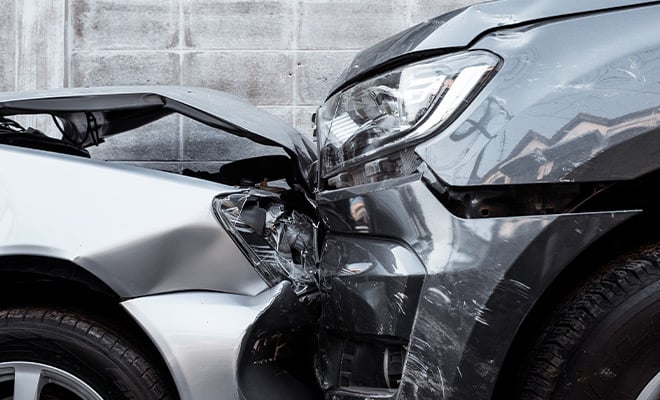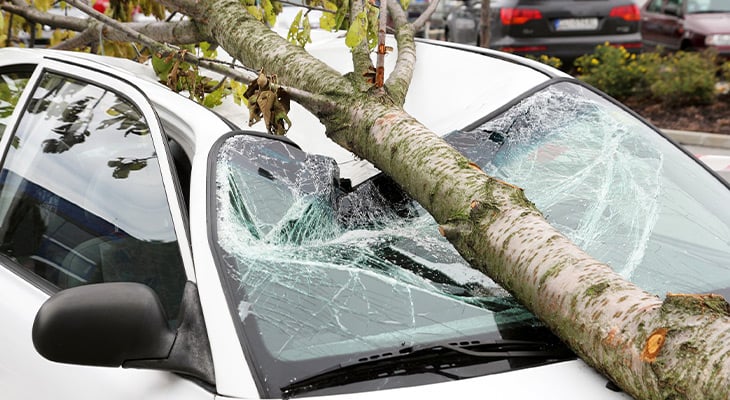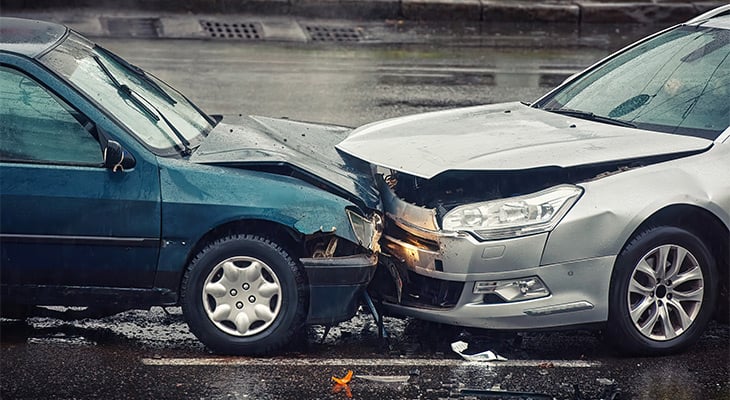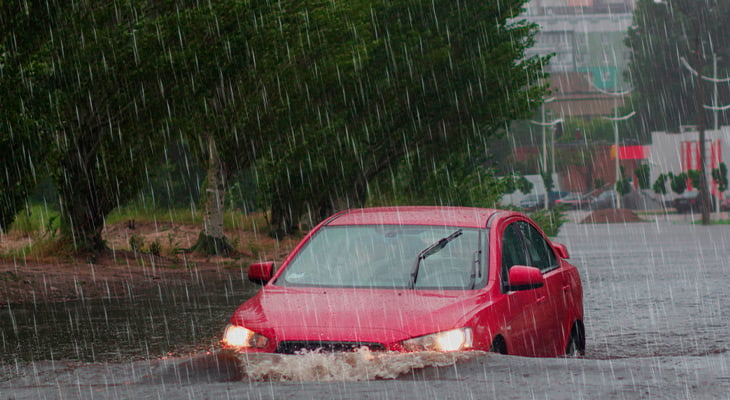Collision vs. Comprehensive Car Insurance: What’s the Difference?
At Compare.com, it’s our mission to find simple ways to help our customers save money on the things they need. While we partner with some of the companies and brands we talk about in our articles, all of our content is written and reviewed by our independent editorial team and never influenced by our partnerships. Learn about how we make money, review our editorial standards, and reference our data methodology to learn more about why you can trust Compare.com.
Collision and comprehensive insurance cover physical damage to your vehicle but for different types of incidents, so it’s essential to understand how they differ. They’re often combined with liability insurance in full-coverage policies and are available from even the cheapest car insurance companies.
If you get into an accident or your car gets stolen, for instance, having these coverages can be worth it. Almost 5% of people with collision insurance filed claims in 2022, while 3.3% of drivers with comprehensive coverage filed claims, according to the Insurance Information Institute (Triple-I).
Keep reading to discover what these coverages offer, their costs, and what factors to consider before purchasing.
Get Cheaper Coverage in Minutes
What’s the Difference Between Comprehensive and Collision Insurance?
Comprehensive and collision coverages pay to repair or replace your vehicle if it gets damaged. The main difference between these types of coverages is the incidents they cover, as shown below.
Collision coverage pays for…
- Damage from driving into another object, such as a tree, fence, or utility pole
- Damage from colliding with another vehicle
- Damage after a single-vehicle rollover accident
- Damage caused by running over an object in the ground or a pothole
Comprehensive coverage pays for…
- Animal damage
- Damage from natural disasters, like a flood, fire, or hurricane
- Damage from a falling object, such as a tree branch or hail
- Damage from vandalism, a civil commotion, or a riot
- Theft of your vehicle or any permanently attached parts, like a radio or wheels
- Broken glass, like a window or windshield
While collision insurance covers damage to your vehicle while driving, comprehensive covers mostly non-collision incidents. Almost 80% of drivers purchase comprehensive coverage, and 75% buy collision insurance, according to Triple-I.
Do You Need Comprehensive and Collision Insurance?
Unlike liability coverage, state laws don’t require you to buy comprehensive and collision insurance. But if you finance or lease your vehicle, the lender or leasing company usually requires you to have them since they protect the company’s interest in your car.
Even if you aren’t required to purchase comprehensive and collision coverage, you might still want them. For instance, these coverages can provide added financial protection if you drive a high-value vehicle or live in an area prone to hazardous weather or with high theft rates.
If you can’t afford to pay for excessive car repairs or to replace your vehicle on your own, the extra premium cost can be worth it.
Now, let’s dive deeper into each type of coverage and what they protect.
What’s Collision Auto Insurance?
Collision car insurance pays for damage to your car if you collide with another vehicle or object or damage it in a single-vehicle rollover. The average collision claim payout was $5,992 in 2022, according to the most recent data available from Triple-I.
Consider adding collision coverage if you want protection for scenarios like:
- Hit-and-runs
- Swerving to avoid an animal in the road and hitting a telephone pole
- Sliding on ice and hitting a guardrail
- Driving over a pothole and damaging your suspension and wheels
What’s Comprehensive Auto Insurance?
Comprehensive car insurance is sometimes called “other than collision” insurance because it covers the types of vehicle damage that collision doesn’t. Some examples of situations where comprehensive coverage would apply are:
- You hit a deer.
- Someone steals or vandalizes your vehicle.
- A hailstorm damages your car.
- A pebble hits and cracks your windshield while you’re driving.
Not sure if comprehensive coverage is worth it? Consider this: more than 1 million vehicle thefts occurred in 2022, according to the National Insurance Crime Bureau (NICB). That’s almost two cars stolen per minute.
Comprehensive vs. Collision Cost
The average monthly cost for comprehensive insurance is $29, while collision insurance averages $62 per month. Collision costs more because the damage to your vehicle is usually more severe, causing higher claim payouts that average twice that of comprehensive claims.
The table below shows the average monthly premiums by state for comprehensive and collision coverage, according to National Association of Insurance Commissioners (NAIC) data.
| State | Average Monthly Comprehensive Premium | Average Monthly Collision Premium | Combined |
|---|---|---|---|
| Alabama | $31 | $63 | $94 |
| Alaska | $26 | $66 | $92 |
| Arizona | $35 | $52 | $87 |
| Arkansas | $41 | $61 | $102 |
| California | $16 | $84 | $100 |
| Colorado | $52 | $54 | $106 |
| Connecticut | $23 | $67 | $90 |
| Delaware | $23 | $58 | $81 |
| Florida | $37 | $88 | $125 |
| Georgia | $26 | $55 | $81 |
| Hawaii | $30 | $69 | $99 |
| Idaho | $18 | $61 | $78 |
| Illinois | $24 | $44 | $69 |
| Indiana | $24 | $58 | $82 |
| Iowa | $23 | $47 | $71 |
| Kansas | $38 | $42 | $80 |
| Kentucky | $47 | $46 | $93 |
| Louisiana | $28 | $48 | $76 |
| Maine | $42 | $75 | $118 |
| Maryland | $21 | $49 | $69 |
| Massachusetts | $28 | $69 | $98 |
| Michigan | $25 | $75 | $100 |
| Minnesota | $28 | $77 | $105 |
| Mississippi | $36 | $45 | $81 |
| Missouri | $41 | $60 | $102 |
| Montana | $37 | $52 | $89 |
| Nebraska | $52 | $48 | $100 |
| Nevada | $45 | $45 | $90 |
| New Hampshire | $19 | $59 | $78 |
| New Jersey | $20 | $54 | $75 |
| New Mexico | $22 | $68 | $90 |
| New York | $37 | $51 | $88 |
| North Carolina | $29 | $76 | $105 |
| North Dakota | $26 | $55 | $81 |
| Ohio | $43 | $47 | $90 |
| Oklahoma | $22 | $49 | $71 |
| Oregon | $45 | $55 | $100 |
| Pennsylvania | $18 | $44 | $62 |
| Rhode Island | $29 | $62 | $91 |
| South Carolina | $25 | $82 | $107 |
| South Dakota | $36 | $52 | $88 |
| Tennessee | $59 | $41 | $100 |
| Texas | $29 | $57 | $86 |
| Utah | $47 | $69 | $115 |
| Vermont | $21 | $50 | $71 |
| Virginia | $26 | $55 | $81 |
| Washington | $25 | $53 | $77 |
| Washington, D.C. | $20 | $52 | $72 |
| West Virginia | $38 | $57 | $95 |
| Wisconsin | $28 | $41 | $69 |
| Wyoming | $59 | $47 | $106 |
| National average | $29 | $62 | $91 |
Florida is the most expensive state for collision and comprehensive coverage, with a combined average monthly premium that’s $34 more than the national average, followed by Maine and Utah. Pennsylvania is the least expensive state — its combined average monthly premium is $29 less than the national average — followed by Illinois and Wisconsin.
Drivers in more densely populated states with severe weather, like Florida, pay more than in states with less-damaging weather.
Car insurance rates vary by state, and factors like crime statistics, population density, the driver’s claims history, and vehicle make and model all affect your premium. Shopping around is crucial if you want the best rates.
Find the Coverage for You
How to lower your comprehensive and collision insurance premium
If you’re looking to get the most protection for the lowest price, check out these ways to save:
- Increase your comprehensive and collision deductibles.
- Compare insurance rates at every policy renewal.
- Buy a cheaper car.
- Pay your policy premiums in full instead of monthly.
- Ask about discounts.
- Bundle your home or renters insurance with your auto insurance policy.
Comprehensive vs. Collision Deductibles
When you file a claim, the deductible is the amount you pay toward repairs, and your insurer pays the rest. For example, if you have a $500 collision deductible and it costs $5,000 to repair your car, your insurer pays $4,500, and you’ll pay $500. If your vehicle is totaled, your insurer will pay its actual cash value (ACV), minus your deductible.
Most comprehensive and collision deductibles are between $50 and $1,000. Each coverage has its own deductible, and you can pick a different one for each. Choosing a higher deductible will lower your premium, but you’ll pay more if you file a claim. Since collision coverage costs more, you might save more with a higher collision deductible.
Some insurers offer a diminishing deductible, which lowers your deductible if you’re a good driver and don’t file a claim for a specific period of time. This feature can offset higher deductibles.
Consider a higher deductible if you’d rather take your chances on not filing a claim and having to pay a deductible. But if you’d prefer the insurance company to cover more if you get in an accident, then a lower deductible may be the better option.
Factors to consider before buying comprehensive and collision coverage
To determine whether you need comprehensive and collision coverage, consider the following factors:
- The value of your car: Expensive cars typically cost more to fix and replace. You might only need to pay your deductible if the damage is covered by comprehensive or collision insurance, instead of the entire cost.
- Where you live: Comprehensive coverage can be valuable if you live in a rural area or one with hazards like falling tree branches and natural disasters.
- Driving habits: You never know when you could slide on ice or hydroplane or if someone could hit you and drive away. Collision insurance will cover the cost of fixing or replacing your car, regardless of fault.
- Your financial situation: Can you afford to repair your vehicle or buy a new one if yours gets totaled? If not, these coverage types can help.
Collision vs. Comprehensive Car Insurance FAQs
We answered some of the most common questions about collision and comprehensive car insurance so you can decide if these coverages are right for you.
Do you need both collision and comprehensive insurance?
It depends. You might need both or neither. Comprehensive and collision insurance provide physical damage coverage for your vehicle. If you can’t afford to replace or repair your car after a car accident or weather damages it, these coverages might be worth it.
Is collision and comprehensive the same as full coverage?
Full coverage is an insurance term that refers to a package of car insurance coverages that protect you financially. A full-coverage car insurance policy typically includes liability, comprehensive, collision, and other coverages your state may require, like personal injury protection (PIP).
When does it make sense to drop comprehensive and collision coverage?
Consider your vehicle’s value and where you live to determine if you should drop comprehensive and collision coverage. For instance, if your car is paid off and not worth much, or you don’t live in an area where natural disasters or animal-related collisions are common, paying extra for these coverages might not make sense.
What is the difference between liability and comprehensive coverage?
Liability insurance covers property damage and injuries you cause to others in an accident. Comprehensive coverage pays for damages to your vehicle caused by non-collision accidents like hitting an animal, broken glass, vandalism, vehicle theft, natural disasters, weather events, and riots or civil unrest.
Is collision the same as liability insurance?
No. Liability insurance covers others’ injuries or property damage you cause while driving. Collision insurance pays for your vehicle damage if you collide with an object or another car or roll your car over in a single-vehicle accident, no matter who’s at fault.
Methodology
Data scientists at Compare.com analyzed more than 50 million real-time auto insurance rates from more than 75 partner insurance providers in order to compile the quotes and statistics seen in this article. Compare.com’s auto insurance data includes coverage analysis and details on drivers’ vehicles, driving records, insurance histories, and demographic information.
All the quotes listed in this article have been gathered from a combination of real Compare.com quotes and external insurance rate data gathered in collaboration with Quadrant Information Services. Compare.com uses these observations to provide drivers with insight into how auto insurance companies determine their premiums.
Sources
- Insurance Information Institute, “Facts + Statistics: Auto insurance,” Accessed January 2, 2024.
- National Association of Insurance Commissioners, “2019/2020 Auto Insurance Database Report,” Accessed January 2, 2024.
- National Insurance Crime Bureau, “‘Hot Spots’ Report Shows Vehicle Theft Rates Spiking in Different Regions of the U.S.,” Accessed January 2, 2024.
Compare Car Insurance Quotes
About Compare.com
Compare.com’s #1 goal is to save you money. We publish resources that are based on hard-hitting data and years of industry experience to help you make more informed decisions with your wallet.
- All of Compare.com’s content is written and reviewed for accuracy by a team of experienced writers and editors who are experts on the topics they cover.
- None of Compare.com’s content is ever influenced by the companies and brands we partner with.
- Compare.com’s editorial team operates independently of any of the company’s partnership or business development interests. We publish unbiased information strictly for the benefit of our readers.
- All of the content you see on Compare.com is based on comprehensive analysis and all data is gathered and vetted from trustworthy sources.
Learn more about us, our team, and what makes us tick.








